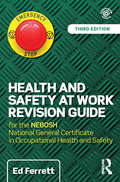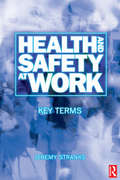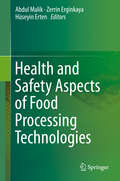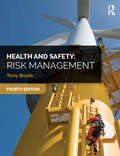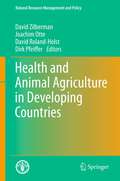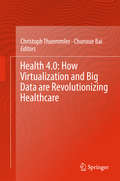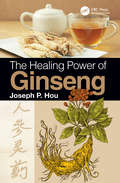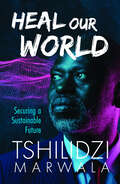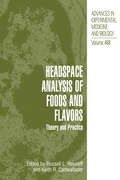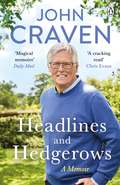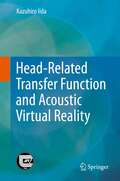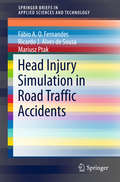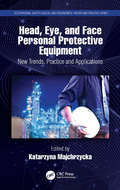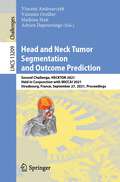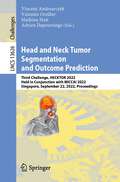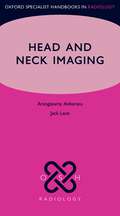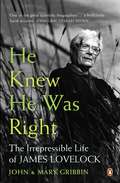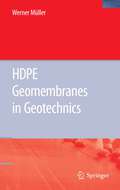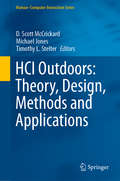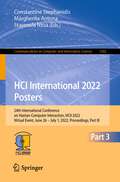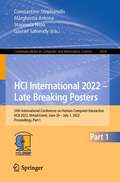- Table View
- List View
Health and Safety at Work Revision Guide: for the NEBOSH National General Certificate in Occupational Health and Safety
by Ed Dr FerrettThis companion to the bestselling Introduction to Health and Safety at Work is an essential revision aid for students preparing for their written assessments on the NEBOSH National General Certificate in Occupational Health and Safety. Fully updated to the latest NEBOSH National General Certificate specifications (April 2015), the revision guide provides complete coverage of the syllabus in bite-sized chunks, helping readers to learn and memorise the most important topics. Throughout the book, the guide refers back to the Introduction to Health and Safety at Work textbook, helping students to consolidate their learning. · Small and portable making it ideal for use anywhere: at home, in the classroom or on the move · Suggests useful tips on study and examination technique · Includes practice questions and answers based on NEBOSH exam questions · Everything you need for productive revision in one handy reference The Health and Safety at Work Revision Guide, written by the renowned health and safety author and former NEBOSH Vice Chairman Ed Ferrett, will be an invaluable tool for students as they prepare for their NEBOSH exam and for their subsequent health and safety work.
Health and Safety at Work Revision Guide: for the NEBOSH National General Certificate in Occupational Health and Safety
by Ed Dr FerrettThis companion to the bestselling Introduction to Health and Safety at Work is an essential revision aid for students preparing for their written assessments on the NEBOSH National General Certificate in Occupational Health and Safety. Fully updated to the latest NEBOSH National General Certificate specifications (April 2015), the revision guide provides complete coverage of the syllabus in bite-sized chunks, helping readers to learn and memorise the most important topics. Throughout the book, the guide refers back to the Introduction to Health and Safety at Work textbook, helping students to consolidate their learning. · Small and portable making it ideal for use anywhere: at home, in the classroom or on the move · Suggests useful tips on study and examination technique · Includes practice questions and answers based on NEBOSH exam questions · Everything you need for productive revision in one handy reference The Health and Safety at Work Revision Guide, written by the renowned health and safety author and former NEBOSH Vice Chairman Ed Ferrett, will be an invaluable tool for students as they prepare for their NEBOSH exam and for their subsequent health and safety work.
Health and Safety at Work: Key Terms
by Jeremy StranksHealth and Safety at Work: Key Terms provides instant information to readers on a range of key terms used in health and safety at work. The book, produced in A-Z format, incorporates the principal legal, technical and practical terms derived from statutes, regulations, approved codes, case law and other appropriate publications. As such, it will be of particular use to health and safety practitioners, those studying for degrees in occupational health and safety and courses run by NEBOSH, and those engaged in enforcement activities, such as Health and Safety Executive inspectors, environmental health officers and fire protection officers.The key terms referenced and explained include: accident statistics; absolute duties; distance guard; noise-induced hearing loss; oxidising classifications; relevant statutory provisions.
Health and Safety at Work: Key Terms
by Jeremy StranksHealth and Safety at Work: Key Terms provides instant information to readers on a range of key terms used in health and safety at work. The book, produced in A-Z format, incorporates the principal legal, technical and practical terms derived from statutes, regulations, approved codes, case law and other appropriate publications. As such, it will be of particular use to health and safety practitioners, those studying for degrees in occupational health and safety and courses run by NEBOSH, and those engaged in enforcement activities, such as Health and Safety Executive inspectors, environmental health officers and fire protection officers.The key terms referenced and explained include: accident statistics; absolute duties; distance guard; noise-induced hearing loss; oxidising classifications; relevant statutory provisions.
Health and Safety Aspects of Food Processing Technologies
by Abdul Malik Zerrin Erginkaya Hüseyin ErtenFood processing is expected to affect content, activity and bioavailability of nutrients; the health-promoting capacity of food products depends on their processing history. Traditional technologies, such as the use of antimicrobials and thermal processing, are efficient in increasing nutritional value to an extent, though they may not be effective at addressing food safety, particularly when it comes to maintaining the food's molecular structure. Modern food processing plants improve the quality of life for people with allergies, diabetics, and others who cannot consume some common food elements. Food processing can also add extra nutrients, such as vitamins. Processed foods are often less susceptible to early spoilage than fresh foods and are better suited for long-distance transportation from the source to the consumer. However, food processing can also decrease the nutritional value of foods and introduce hazards not encountered with naturally occurring products. Processed foods often include food additives, such as flavourings and texture-enhancing agents, which may have little or no nutritive value, and may in fact be unhealthy.This book deals with the subject of food processing in a unique way, providing an overview not only of current techniques in food processing and preservation (i.e., dairy, meat, cereal, vegetables, fruits and juice processing, etc.) but also the health and safety aspects: food technologies that improve nutritional quality of foods, functional foods, and nanotechnology in the food and agriculture industry. The text also looks into the future by defining current bottlenecks and future research goals. This work will serve as a ready reference for the subject matter to students and researchers alike.
Health and Safety: Risk Management
by Tony BoyleHealth and Safety: Risk Management is the clearest and most comprehensive book on risk management available today. This newly revised fourth edition integrates new developments in legislation, standards and practice, and incorporates up-to-date information for qualification syllabuses. The book is divided into four main parts. Part 1.1 is primarily concerned with the fundamentals of risk management and is relevant for all students of health and safety, while Part 1.2 covers the required basic human factors material required for health and safety qualifications. Part 2.1 deals with the more advanced aspects of risk management, while Part 2.2 covers the more advanced human factors material required by those studying for qualifications in health and safety. This authoritative treatment of risk management is essential reading for both students working towards degrees, diplomas and postgraduate or vocational qualifications in health and safety and experienced health and safety professionals, who will find it invaluable as a reference.
Health and Animal Agriculture in Developing Countries (Natural Resource Management and Policy #36)
by David Zilberman, Joachim Otte, David Roland-Holst and Dirk PfeifferThis book provides an overview of the state of animal agriculture and present methodologies and proposals to develop policies that result in sustainable and profitable animal production that will protect human and environmental health, enhance livelihood of smallholders and meet consumer needs. The book combines lessons of the past, factual foundation to understand the present, analytical tools to design and improve policies, case studies that provide both empirical grounding and applications of some of the strategies suggested in this book, and finally, a proposal for the way forward.
Health 4.0: How Virtualization and Big Data are Revolutionizing Healthcare
by Christoph Thuemmler Chunxue BaiThis book describes how the creation of new digital services—through vertical and horizontal integration of data coming from sensors on top of existing legacy systems—that has already had a major impact on industry is now extending to healthcare. The book describes the fourth industrial revolution (i.e. Health 4.0), which is based on virtualization and service aggregation. It shows how sensors, embedded systems, and cyber-physical systems are fundamentally changing the way industrial processes work, their business models, and how we consume, while also affecting the health and care domains. Chapters describe the technology behind the shift of point of care to point of need and away from hospitals and institutions; how care will be delivered virtually outside hospitals; that services will be tailored to individuals rather than being designed as statistical averages; that data analytics will be used to help patients to manage their chronic conditions with help of smart devices; and that pharmaceuticals will be interactive to help prevent adverse reactions. The topics presented will have an impact on a variety of healthcare stakeholders in a continuously global and hyper-connected world.· Presents explanations of emerging topics as they relate to e-health, such as Industry 4.0, Precision Medicine, Mobile Health, 5G, Big Data, and Cyber-physical systems;· Provides overviews of technologies in addition to possible application scenarios and market conditions; · Features comprehensive demographic and statistic coverage of Health 4.0 presented in a graphical manner.
The Healing Power of Ginseng
by Joseph P. HouHealth and medical uses of ginseng is broad due to its adaptogenic properties, it is an effective tonic. Ginseng can be used to improve mental and physical performance, reduce stress, and increase longevity. This book covers the properties and uses of four varieties of ginseng in the world with focus on American and Asian types of ginseng. This books discusses healing properties of ginseng, growing ginseng plants, chemical, nutritional, medical and pharmacological properties, detoxification, longevity and proper usage of the root.
The Healing Power of Ginseng
by Joseph P. HouHealth and medical uses of ginseng is broad due to its adaptogenic properties, it is an effective tonic. Ginseng can be used to improve mental and physical performance, reduce stress, and increase longevity. This book covers the properties and uses of four varieties of ginseng in the world with focus on American and Asian types of ginseng. This books discusses healing properties of ginseng, growing ginseng plants, chemical, nutritional, medical and pharmacological properties, detoxification, longevity and proper usage of the root.
Heal our World: Securing a Sustainable Future
by Tshilidzi MarwalaThe world is emerging from the COVID-19 pandemic, more fragmented and further away from the more equal and equitable iteration imagined in 2015 when the Sustainable Development Goals (SDGs) were conceptualised.As we hurtle at seemingly lightning speed towards the 2030 deadline to achieve these goals, the urgency is palpable. Although we have certainly strayed further away from the targets, there is still time to act in order to ensure that we inch closer to this vision.Professor Tshilidzi Marwala paints a stark, and often grim, picture of our current context, one defined by monumental setbacks in the SDGs. Yet, as he carves out each developmental goal and its implications, it is apparent that there are tangible solutions that can be implemented now.Tshilidzi’s assertion that now is the time to act is backed by intricate and actionable data with a simple mission statement: we must heal the future.He offers a new narrative that addresses how we can translate the latent potential that exists through technology, innovation and Fourth Industrial Revolution approaches to leadership and policy making to deal with, among others, corruption, poverty eradication, joblessness, an education system in crisis, declining economies and food insecurity.Heal our World is a deep dive into the SDGs, particularly in the African context, and it looks toward securing a future in which our divisions are blurred, and our goals seem almost in reach again.Tshilidzi Marwala, the author of Heal our World, Leading in the 21st Century and Leadership Lessons from Books I Have Read is the Vice-Chancellor and Principal of the University of Johannesburg. From 1 March 2023, he will be the Rector of the United Nations University based in Tokyo, Japan. He was previously Deputy Vice-Chancellor for Research and Executive Dean of the Faculty of Engineering at the University of Johannesburg and Full Professor at the Carl & Emily Fuchs Chair of Systems and Control Engineering at the University of the Witwatersrand.Tshilidzi holds a Bachelor of Science in Mechanical Engineering (magna cum laude) from Case Western Reserve University, a PhD in Artificial Intelligence from the University of Cambridge and a Post-Doc at Imperial College (London). He is a member of the American Academy of Arts and Sciences, The World Academy of Sciences (TWAS), the Academy of Science of South Africa (ASSAf), the African Academy of Sciences (AAS) and the South African Academy of Engineering (SAAE). He is a distinguished member of the Association for Computing Machinery (ACM). His research interests are multidisciplinary and include the theory and application of artificial intelligence to engineering, computer science, finance, social science and medicine.He has supervised 37 doctoral students. He has also published 23 books on artificial intelligence (one translated into Chinese) and over 300 papers in journals, proceedings, book chapters and magazines. He holds five international patents.
Headspace Analysis of Foods and Flavors: Theory and Practice (Advances in Experimental Medicine and Biology #488)
by Keith R. Cadwallader Russell L. RouseffHeadspace gas analysis is an analytical technique that has been successfully applied to food flavors for over 20 years but has experienced a resurgence of interest and innovation in recent years. In its truest form, headspace analysis represents the direct collection and analysis of the mixture of vapors in the space immediately above a food or beverage. The technique offers several advantages for workers interested in how a product smells and ultimately tastes. It offers the advantages of speed, simplicity, and, more importantly, represents the aroma profile a consumer is likely to experience just before consuming the product. Since only volatile components are collected, the sample is totally free of nonvolatile residues which commonly plague comparison liquid-liquid extracts of the same product. This is the first book devoted to headspace analysis in foods and beverages in more than 20 years. The publication contains chapters on the basic theory of headspace analysis, as well as the theory and application of newly developed headspace techniques, such as solid phase micro extraction, SPME and electronic noses. New concentrating and desorption techniques are described in addition to a raft of food applications including tomato and citrus juices, alcoholic beverages, baguettes, dairy products, lipids, grill flavoring, baked potato, and meat. Chapters on off-flavors as well as aroma-food matrix interactions are also included. "This is the bible of headspace analysis. If you are involved in, or planning on becoming involved, or want to learn more about, this incredible subject , then buy this book immediately!" – Aubrey Parsons, governing council member, International Union for Food Science and Technology
Headlines and Hedgerows: A Memoir
by John CravenDiscover the first and only memoir from national treasure John Craven, as he recounts both the highs and the lows of one of the longest entertaining careers in history, and the people, family and animals that have shaped it.'Magical memoirs. A BBC legend. A broadcasting icon. The best bits from cub reporter to Countryfile . . . his early career sounds like a riot' Mail on SundayBorn in Leeds, John showed an early interest in newspapers when, aged eleven, he wrote the 'Grimthorpe Street Gazette': a one-page paper detailing the latest goings-on in his street. It was a short-lived enterprise, not least as he only had one copy of it - which he charged neighbours a penny to borrow and read.But it was while working as a journalist at the Yorkshire Post that he heard of a new opening at the BBC - a move that was to change his life forever... Throughout the 1970s and 80s, John was, to children and parents alike, a friendly guide to the big wide world through Newsround, making news accessible for everyone. Since then, having presented Countryfile from across the breadth of Britain for 30 years, John has introduced us to the people, landscapes and animals which make it so special.He has been telling the story of Britain since 1970, and now you can read the story of his own life in this entertaining memoir.
Head-Related Transfer Function and Acoustic Virtual Reality
by Kazuhiro IidaThis book covers all aspects of head-related transfer function (HRTF), from the fundamentals through to the latest applications, such as 3D sound systems. An introductory chapter defines HRTF, describes the coordinate system used in the book, and presents the most recent research achievements in the field. HRTF and sound localization in the horizontal and median planes are then explained, followed by discussion of individual differences in HRTF, solutions to this individuality (personalization of HRTF), and methods of sound image control for an arbitrary 3D direction, encompassing both classic theory and state of the art data. The relations between HRTF and sound image distance and between HRTF and speech intelligibility are fully explored, and measurement and signal processing methods for HRTF are examined in depth. Here, supplementary material is provided to enable readers to measure and analyze HRTF by themselves. In addition, some typical HRTF databases are compared. The final two chapters are devoted to the principles and applications of acoustic virtual reality. This clearly written book will be ideal for all who wish to learn about HRTF and how to use it in their research.
Head Injury Simulation in Road Traffic Accidents (SpringerBriefs in Applied Sciences and Technology)
by Fábio A. Fernandes Ricardo J. Alves de Sousa Mariusz PtakIn this work the development of a new geometrically detailed finite element head model is presented. Special attention is given to sulci and gyri modelling, making this model more geometrically accurate than others currently available. The model was validated against experimental data from impact tests on cadavers, specifically intracranial pressure and brain motion. Its potential is shown in an accident reconstruction case with injury evaluation by effectively combining multibody kinematics and finite element methodology.
Head, Eye, and Face Personal Protective Equipment: New Trends, Practice and Applications (Occupational Safety, Health, and Ergonomics)
by Katarzyna MajchrzyckaHead, Eye, and Face Personal Protective Equipment: New Trends, Practice, and Applications presents protective equipment in the context of the latest design trends, materials, and technologies. It informs the reader using basic safety principles to avoid issues with commonly used personal protective equipment (PPE), such as helmets and eye and face protectors. It provides the latest design trends in eye and face protectors to avoid optical hazards and for use in variable lighting conditions. Features: • Fills the gap on current solutions of PPE and occupational safety • Educates in reducing risk connected with using industrial safety gear • Helpful to optometrists in the selection of eye protection for people with visual impairments • Instructs the reader on choosing smart materials and safety products • Provides best practices for checking the technical condition of the equipment This book is essential for the safety professional and medical experts in the field. It provides an interdisciplinary approach to personal protective equipment using new technologies in the field. "The monograph Head, Eye, and Face Personal Protective Equipment - New Trends, Practice and Applications is a complementary and thoughtful but selected compilation of the most relevant information concerning protective helmets as well as eye and face protection. The compilation of these two protection types is the result of the common use of both protective helmets and eye and face protectors. This requires their full compatibility, both in terms of ensuring optimum safety and comfort of use. The authors have chosen the material according to the needs of people directly responsible for safety at work and users of those protectors. The main aim of the work is to popularise knowledge in the field of construction, research methods, selection and use of protective helmets and eye and face protectors. In terms of use, the authors emphasise the necessity of independent control, i.e. checking the technical condition of the equipment used by the end users. The presented monograph includes the current state of knowledge in this scope, extended by the results and summaries of the authors' own research. All requirements and research methods are given based on European (EN), international (ISO) standards and standards operating in different geographical areas. The monograph also encompasses new trends in the design of protective helmets and eye and face protectors. All this allows me to emphasize the uniqueness of this monograph in relation to previous publications in this field, both in terms of the scope and selection of information concerning protective helmets and eye and face protectors."— Ryszard Korycki, Łódź University of Technology
Head, Eye, and Face Personal Protective Equipment: New Trends, Practice and Applications (Occupational Safety, Health, and Ergonomics)
by Katarzyna MajchrzyckaHead, Eye, and Face Personal Protective Equipment: New Trends, Practice, and Applications presents protective equipment in the context of the latest design trends, materials, and technologies. It informs the reader using basic safety principles to avoid issues with commonly used personal protective equipment (PPE), such as helmets and eye and face protectors. It provides the latest design trends in eye and face protectors to avoid optical hazards and for use in variable lighting conditions. Features: • Fills the gap on current solutions of PPE and occupational safety • Educates in reducing risk connected with using industrial safety gear • Helpful to optometrists in the selection of eye protection for people with visual impairments • Instructs the reader on choosing smart materials and safety products • Provides best practices for checking the technical condition of the equipment This book is essential for the safety professional and medical experts in the field. It provides an interdisciplinary approach to personal protective equipment using new technologies in the field. "The monograph Head, Eye, and Face Personal Protective Equipment - New Trends, Practice and Applications is a complementary and thoughtful but selected compilation of the most relevant information concerning protective helmets as well as eye and face protection. The compilation of these two protection types is the result of the common use of both protective helmets and eye and face protectors. This requires their full compatibility, both in terms of ensuring optimum safety and comfort of use. The authors have chosen the material according to the needs of people directly responsible for safety at work and users of those protectors. The main aim of the work is to popularise knowledge in the field of construction, research methods, selection and use of protective helmets and eye and face protectors. In terms of use, the authors emphasise the necessity of independent control, i.e. checking the technical condition of the equipment used by the end users. The presented monograph includes the current state of knowledge in this scope, extended by the results and summaries of the authors' own research. All requirements and research methods are given based on European (EN), international (ISO) standards and standards operating in different geographical areas. The monograph also encompasses new trends in the design of protective helmets and eye and face protectors. All this allows me to emphasize the uniqueness of this monograph in relation to previous publications in this field, both in terms of the scope and selection of information concerning protective helmets and eye and face protectors."— Ryszard Korycki, Łódź University of Technology
Head and Neck Tumor Segmentation and Outcome Prediction: Second Challenge, HECKTOR 2021, Held in Conjunction with MICCAI 2021, Strasbourg, France, September 27, 2021, Proceedings (Lecture Notes in Computer Science #13209)
by Vincent Andrearczyk Valentin Oreiller Mathieu Hatt Adrien DepeursingeThis book constitutes the Second 3D Head and Neck Tumor Segmentation in PET/CT Challenge, HECKTOR 2021, which was held in conjunction with the 24th International Conference on Medical Image Computing and Computer-Assisted Intervention, MICCAI 2021. The challenge took place virtually on September 27, 2021, due to the COVID-19 pandemic.The 29 contributions presented, as well as an overview paper, were carefully reviewed and selected form numerous submissions. This challenge aims to evaluate and compare the current state-of-the-art methods for automatic head and neck tumor segmentation. In the context of this challenge, a dataset of 325 delineated PET/CT images was made available for training.
Head and Neck Tumor Segmentation and Outcome Prediction: Third Challenge, HECKTOR 2022, Held in Conjunction with MICCAI 2022, Singapore, September 22, 2022, Proceedings (Lecture Notes in Computer Science #13626)
by Vincent Andrearczyk Valentin Oreiller Mathieu Hatt Adrien DepeursingeThis book constitutes the Third 3D Head and Neck Tumor Segmentation in PET/CT Challenge, HECKTOR 2022, which was held in conjunction with the 25th International Conference on Medical Image Computing and Computer-Assisted Intervention, MICCAI 2022, on September 22, 2022.The 22 contributions presented, as well as an overview paper, were carefully reviewed and selected from 24 submissions. This challenge aims to evaluate and compare the current state-of-the-art methods for automatic head and neck tumor segmentation. In the context of this challenge, a dataset of 883 delineated PET/CT images was made available for training.
Head and Neck Imaging (Oxford Specialist Handbooks in Radiology)
by Arangasamy Anbarasu Jack LaneUsing the succinct and practical Oxford Specialist Handbook format, Head and Neck Imaging is an introduction to the theory and practice of head and neck radiology, as well as a guide to choosing and performing imaging investigations and minimally invasive procedures. Providing an overview of this challenging subspecialty, Head and Neck Imaging covers anatomy and the different diagnoses in head and neck radiology in an easily comprehensible way. Bulleted summaries of key facts in epidemiology, imaging features, prognosis and treatment guide the reader through the various imaging techniques and the ways they have direct clinical application. Highly illustrated with examples of the various imaging techniques to aid understanding, this is the definitive guide to head and neck radiology, and an ideal tool for radiology trainees and practitioners.
He Knew He Was Right: The Irrepressible Life of James Lovelock
by John GribbinJim Lovelock is an iconic figure in British science, a prophet whose prophecies are coming true. This is his definitive authorised biography. Lovelock is best known as the 'father' of Gaia theory, which isnow established as the most useful way of understanding the dramatic changes happening to the environment of the Earth.But few people know about his early work as a chemist and inventor - work which included inventing the detectors used to search for life on Mars, and blowing the whistle on the depletion of ozone layer. In his personal life, he was a Quaker and conscientious objector in World War Two (later changing his mind in view of the evils of Nazism), supported his family for a time by selling his own blood, and gave up a salary and security to become an independent scientist based in an English village - from which all his best known work emerged.As he approaches his 90th birthday, looking forward to going into space, this book truly reveals an independent, original and inspiring life.
HDPE Geomembranes in Geotechnics
by Werner W. MüllerHigh-density Polyethylene (HDPE) geomembranes are widely used for liners and sealings in geotechnical engineering. Common applications include lining of ponds, dams and dykes, landfill underliners and cover systems, remediation of contaminated sites, waterproofing for tunnels, and beneath highways. This handbook covers all aspects of the field: basic materials, geomembrane manufacture, textured geomembranes, long-term performance and testing, installation and welding of geomembranes, quality assurance and control, leak detection, standards, recommendations and regulations.
HCI Outdoors: Theory, Design, Methods and Applications (Human–Computer Interaction Series)
by D. Scott McCrickard Michael Jones Timothy L. StelterAdvances in network connectivity, power consumption, and physical size create new possibilities for using interactive computing outdoors. However, moving computing outdoors can drastically change the human outdoor experience. This impact is felt in many kinds of outdoor activities such as citizen science, personal recreation, search and rescue, informal education, and others. It is also felt across outdoor settings that range from remote wilderness to crowded cities. Understanding these effects can lead to ideas, designs and systems that improve, rather than diminish, outdoor experiences. This book represents the current results emerging from recent workshops focused on HCI outdoors and held in conjunction with CHI, GROUP, UbiComp, and MobileHCI conferences. Based on feedback at those workshops, and outreach to other leaders in the field, the chapters collected were crafted to highlight methods and approaches for understanding how technologies such as handhelds, wearables, and installed standalone devices impact individuals, groups, and even communities. These findings frame new ways of thinking about HCI outdoors, explore logistical issues associated with moving computing outdoors, and probe new experiences created by involving computing in outdoor pursuits. Also important are the ways that social media has influenced preparation, experience, and reflection related to outdoor experiences. HCI Outdoors: Theory, Design, Methods and Applications is of interest to HCI researchers, HCI practitioners, and outdoor enthusiasts who want to shape future understanding and current practice related to technology in every kind of outdoor experience.
HCI International 2022 Posters: 24th International Conference on Human-Computer Interaction, HCII 2022, Virtual Event, June 26 – July 1, 2022, Proceedings, Part III (Communications in Computer and Information Science #1582)
by Margherita Antona Constantine Stephanidis Stavroula NtoaThe four-volume set CCIS 1580, CCIS 1581, CCIS 1582, and CCIS 1583 contains the extended abstracts of the posters presented during the 24th International Conference on Human-Computer Interaction, HCII 2022, which was held virtually in June - July 2022. The total of 1276 papers and 275 posters included in the 40 HCII 2021 proceedings volumes was carefully reviewed and selected from 5583 submissions.The posters presented in these four volumes are organized in topical sections as follows: Part I: user experience design and evaluation; visual design and visualization; data, information and knowledge; interacting with AI; universal access, accessibility and design for aging. Part II: multimodal and natural interaction; perception, cognition, emotion and psychophysiological monitoring; human motion modelling and monitoring; IoT and intelligent living environments. Part III: learning technologies; HCI, cultural heritage and art; eGovernment and eBusiness; digital commerce and the customer experience; social media and the metaverse. Part IV: virtual and augmented reality; autonomous vehicles and urban mobility; product and robot design; HCI and wellbeing; HCI and cybersecurity.
HCI International 2022 – Late Breaking Posters: 24th International Conference on Human-Computer Interaction, HCII 2022, Virtual Event, June 26 – July 1, 2022, Proceedings, Part I (Communications in Computer and Information Science #1654)
by Constantine Stephanidis Margherita Antona Stavroula Ntoa Gavriel SalvendyVolume CCIS 1654 is part of the refereed proceedings of the 24th International Conference on Human-Computer Interaction, HCII 2022, which was held virtually during June 26 to July 1, 2022. A total of 5583 individuals from academia, research institutes, industry, and governmental agencies from 88 countries submitted contributions, and 1276 papers and 275 posters were included in the proceedings that were published just before the start of the conference. Additionally, 296 papers and 181 posters are included in the volumes of the proceedings published after the conference, as “Late Breaking Work” (papers and posters). The contributions thoroughly cover the entire field of human-computer interaction, addressing major advances in knowledge and effective use of computers in a variety of application areas.
